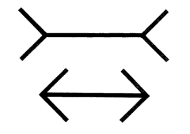Object that appears to be bigger 'feels' less heavy

The 'Müller-Lyer illusion' is not a phenomenon that sounds familiar to many people. However, most of us have seen the image of two arrow-like lines, one with normal arrowheads at each end and the second with inverted arrows at each end. The line with the inverted arrows appears to be longer. This is an optical illusion that the German psychologist Franz Müller-Lyer described a century ago. Veni researcher Myrthe Plaisier (VU Amsterdam) and her colleagues discovered that if you allow study subjects to lift two identical brass bars with ordinary and 'inverted' cardboard arrows attached to their ends, they then think that one object is not only longer but also lighter than the other. And that is a new discovery. The article 'How Heavy Is an Illusory Length?' was published in the online magazine i-Perception.
Human perception of the characteristics of an object, such as size and weight, can be subject to illusions. Such a sensory illusion occurs, for example, if a person underestimates the weight of a large object compared to a small object with the same weight. Differences in material also have an influence on that: a block of marble can appear to be heavier than an equally large block of polystyrene foam that has been altered to have the same weight. The French researcher Augustin Charpentier published a subsequently famous article about this at the end of the 19th century in which he described such an experiment for the first time.
Myrthe Plaisier: 'But research has also shown that visual and sensorimotor perception can be independent of each other. Our question was therefore: can a visual illusion of the size of an object also influence how heavy an object "feels"? And our laboratory research demonstrated that it can.'
Cardboard arrows
On each occasion, study subjects examined two bars whose observed length was influenced by the cardboard 'Müller-Lyer' arrows attached to them. The subjects subsequently gave a verbal estimation of the length of the brass bars. During a subsequent session – on a different day, to prevent disruption of the length and weight perception – the participants had to give an estimate of the weight. During this latter session, they consistently judged that the apparently longer object appeared to be lighter in weight, even though both bars were identical except for the cardboard arrows.
The researchers concluded that an increase of 5 millimetres in the illusory length corresponded with a decrease of 15 grams in the illusory weight.
More information: A. J. de Brouwer et al. How Heavy Is an Illusory Length?, i-Perception (2016). DOI: 10.1177/2041669516669155


















